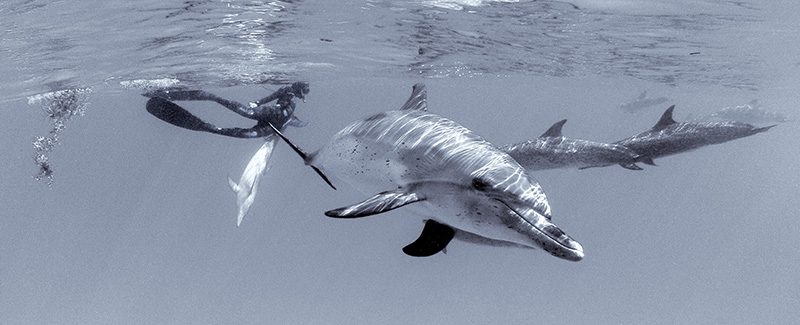IN THE 1900s UMBERTO PELIZZARI was a young diver from Busto Arsizio, Italy, who was making headlines by breaking world records in constant weight and variable weight freediving. Needing an edge against his archrival, Francisco “Pipin” Ferreras, he sought advice on fins from a friend who was knowledgeable about innovative freediving equipment: Valerio Grassi, founder of Omersub.
Car-racing technology had started using composites, so the two friends designed some prototype composite fins for future trials. Pelizzari’s goal was to eventually exceed 80 meters on a single breath in a constant weight freedive. Using his composite freediving fins, he went on to set numerous records and reached his goal, establishing a new world record with an 80-meter constant weight freedive in October 1999. Bob Talbot’s 2001 IMAX film Ocean Men: Extreme Dive features the storied rivalry between Pelizzari and Ferreras.
With nearly 25 years of experience in the dive equipment industry, I’ve witnessed all the changes and advancements in freediving fins. In the 1990s the major manufacturers produced plastic long-blade fins in similar lengths but with subtle differences in the blade geometrics and terminal shapes. Some more advanced designs integrated a bend in the plant of the fin blades where they attach to the foot pockets. Some fins were modular designs with foot pockets connected via clips and screws to the blade; others were molded one-piece designs.
The jury was out as to which design was ultimately better. The working theory at that time was that stiffer blades would propel a diver more. Divers descending to depths needed added thrust, and the additional negative buoyancy past 2 to 3 atmospheres required an extra boost from the blade to get the diver back to the surface.

Diverse materials — including the fiberglass, Kevlar, carbon fiber, and even clear optical industry materials — were integrated into fins. Freedivers wanting a performance edge experimented with materials that would provide the most efficient propulsion and energy conservation for oxygen-starved freedivers plummeting to and returning from depth.

By the early 2000s a few manufacturers produced and marketed open-heel long-blade fins, not so much for freedivers but for scuba divers who wore booties and wanted a quick on and off slip-in design with straps. These fins were well suited for divers in heavy current, doing long drift dives, and for chasing down students. New materials later changed the game for freediving long-blade fins. The markets went from 95 percent plastic polymer and thermoplastics — fancy names for polyamide and plastic derivatives used in injection molding — to a wide variety of composite materials.
The functionality of freediving fins accelerated from this point forward. What hadn’t changed since the plastic fins of the 1970s now evolved with the use of composite materials for blades and modular thermoplastic multicompound foot pockets that were joined separately to the fin blades.
The change to new materials for fins was rooted in a desire for safety due to an increase in freediving accidents. Counter to the earlier belief that stiffer blades were better at depth, it turned out to be a deadly recipe for shallow-water blackout. Divers going deep required the extra stiffness to overcome the additional negative buoyancy, but the added stiffness for a laboring freediver working toward the surface overly strained their leg muscles.
Manufacturers concluded that blade stiffness requirements depended on the diver’s body type and stature, perhaps not interpolating the general freediving population. Design evolved to alternate materials for energy and weight savings.
Carbon fiber is generally regarded as the most efficient material for freediving fins — not only for its excellent stiffness-to-weight relationship but also for its responsiveness and reactivity. Properly molded carbon fiber freediving fins with the right stiffness will efficiently propel the diver to depth by minimizing wasted energy.
As a general starting point for determining fin hardness or stiffness, a diver who weighs less than 150 pounds (68 kilograms) would typically select a soft or 20-25 stiffness fin blade. A diver weighing between 175 and 200 pounds (79 and 91 kilograms) would typically use a medium or 30 stiffness, and a heavier diver would want a hard or 40 stiffness fin blade, but there are exceptions to these recommendations. Some instructors and professionals, for example, prefer fin blades that are stiffer than their stature would indicate to provide quicker response and propulsion.
Carbon fin blades are also available in different shapes and lengths. Long but light fins create less fatigue in a diver’s quadriceps. The extra blade length propels the diver with fewer kicks compared with regular-length fins. By displacing larger volumes of water, long fins allow the cadence to slow to longer, smoother, full rotation kicks with less sculling.
Carbon fiber fins weigh about 1 to 1.5 pounds (453 a 680 grams) each, and the foot pockets generally join with a set screw kit to the blade. With closed-heel pockets, divers typically wear 2 mm to 3 mm socks, which are too thin for coldwater divers, who usually use an open-heel strap fin with neoprene boots to keep their feet warm.
The most important variable when choosing a proper fin is the fit of the foot pocket. Once you achieve a comfortable, snug foot pocket, you can easily narrow down the blades based on a few criteria, such as your stature, the depth you most commonly dive, and the type of freediving or sport diving you do — such as spearfishing, photography, depth attempts, or surface-based swimming.
Many fins are modular, meaning the blades come apart so you can change them out or to make it easier for traveling. A proper freediving fin bag is a great investment for airline travel so you can pack your essentials in it and store it the overhead compartment. Carbon fiber is stronger than plastic and are quite durable when used as intended. AD
© Alert Diver — Q4 2023